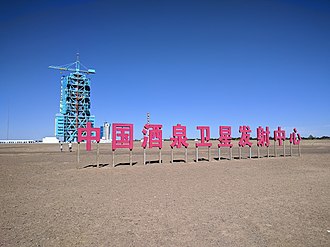Difference between revisions of "Jiuquan Satellite Launch Center"
m ((GR) File renamed: File:Jiuqiuan Launch Vehicle Vertical Assembly Building.png → File:Jiuquan Launch Center Vertical Assembly Building.png Criterion 3 (obvious error)) |
m (1 revision imported) |
(No difference)
| |
Latest revision as of 23:47, 23 February 2022
Lua error in Module:Coordinates at line 492: attempt to index field 'wikibase' (a nil value).
| Jiuquan Satellite Launch Center | |
|---|---|
酒泉卫星发射中心 | |
 Launch of a LM-2D at Jiuquan Satellite Launch Center | |
| Alternative names | Dongfeng Aerospace City |
| General information | |
| Status | Complete |
| Location | Ejin, Alxa, Inner Mongolia |
| Coordinates | 40°57′29″N 100°17′28″E / 40.95806°N 100.29111°E Fatal error: The format of the coordinate could not be determined. Parsing failed. |
| Opened | 1958 |
| Jiuquan Satellite Launch Center | |||||||||
|---|---|---|---|---|---|---|---|---|---|
| Simplified Chinese | 酒泉卫星发射中心 | ||||||||
| Traditional Chinese | 酒泉衛星發射中心 | ||||||||
| |||||||||

Jiuquan Satellite Launch Center (JSLC; Chinese: 酒泉卫星发射中心; pinyin: Jiǔquán Wèixīng Fāshè Zhōngxīn also known as Shuangchengzi Missile Test Center; Launch Complex B2; formally Northwest Comprehensive Missile Testing Facility (西北综合导弹试验基地); Base 20; 63600 Unit)[1] is a Chinese space vehicle launch facility (spaceport) located in the Gobi Desert, Inner Mongolia. It is part of the Dongfeng Aerospace City (Base 10). Although the facility is geographically located within Ejin Banner of Inner Mongolia's Alxa League, it is named after the nearest city, Jiuquan in Gansu Province. The launch center straddles both sides of the Ruo Shui river.[2]
History
It was founded in 1958, the first of China's four spaceports. As with all Chinese launch facilities, it is remote and generally closed to foreigners.
The Satellite Launch Center is a part of Dongfeng Space City (东风航天城), also known as Base 10 (十号基地) or Dongfeng base (东风基地). The Dongfeng site also includes PLAAF test flight facilities, a space museum and a martyr's cemetery (东风烈士陵园).[3]
JSLC is usually used to launch vehicles into lower and medium orbits with large orbital inclination angles, as well as testing medium to long-range missiles. Its facilities are state of the art and provide support to every phase of a satellite launch campaign.[citation needed] The site includes the Technical Center, the Launch Complex, the Launch Control Center, the Mission Command and Control Center and various other logistical support systems.
The center covers 2800 km² and may have housing for as many as 20,000 people. The facilities and launch support equipment were likely modelled on Soviet counterparts and the Soviet Union likely provided technical support to Jiuquan.
The launch center has been the focus of many of China's ventures into space, including their first satellite Dong Fang Hong I in 1970, and their first crewed space mission Shenzhou 5 on 15 October 2003. As of 2021, all Chinese crewed space flights, meaning all flights in the Shenzhou program including crewed flights to the Tiangong space station, have launched from Jiuquan.
In August 2016, China launched the first quantum communication satellite, the "Quantum Experiments at Space Scale", from the Center.[4]
In August 2018, Chinese private rocket manufacturing startups i-Space and OneSpace launched sub-orbital rockets from the center.[5] On July 25, 2019, the first Chinese private orbital launch took place from Jiuquan as I-Space launched their Hyberbola-1 rocket.
Launch pads
The launch pads at Launch Area 2 are located at approximately 41.308833° north, 100.316512° east (north pad) and 41.306143° north, 100.313229° east (south pad).[6]
- Launch Area 3, 2 launch pads: DF-1, DF-2, R-2.
Launch Area 3 is approximately 2.7 km south of Launch Area 2. The launch pads are located at approximately 41.283190° north, 100.304706° east (north pad) and 41.280457° north, 100.304582° east (south pad).
- Launch Area 4 (South Launch Site), 2 launch pads, only active complex:
- SLS-1: CZ-2F launcher with nearby Vertical Assembly Facility.
- SLS-2: CZ-2C, CZ-2D, CZ-4B, CZ-4C and CZ-11, operational since 2003
Launch Area 4 is approximately 37.9 km south of Launch Area 3. The launch pads are located at approximately 40.960671° north, 100.298186° east (north pad) and 40.957893° north, 100.290944° east (south pad).
See also
Lua error in mw.title.lua at line 318: bad argument #2 to 'title.new' (unrecognized namespace name 'Portal').
- Chinese space program
- Taiyuan Satellite Launch Center
- Wenchang Satellite Launch Center
- Xichang Satellite Launch Center
References
- ↑ "Jiuquan Space Launch Center - Facilities - NTI". www.nti.org. Retrieved 21 January 2019.
- ↑ https://www.bloomberg.com/graphics/2016-asia-space-race/chinasidebar.html
- ↑ "航天科技游圣地——东风航天城 (The Jerusalem of the space tech journey-Dongfeng space city)" (in 中文). 新华网内蒙古频道 (Xinhua network inner-Mongol channel). 5 December 2007. Archived from the original on 24 July 2009. Retrieved 7 May 2008.
- ↑ "China Launches Pioneering 'Hack-Proof' Quantum-Communications Satellite". space.com. Space.com. 16 August 2016. Retrieved 16 August 2016.
- ↑ Jones, Andrew (7 September 2018). "Chinese startups OneSpace, iSpace succeed with suborbital launches". Retrieved 10 September 2018.
- ↑ "Google Maps". Google Maps. Retrieved 15 June 2017.
External links
- Base 20 Jiuquan Space Facility on GlobalSecurity.org
- Pages with script errors
- CS1 中文-language sources (zh)
- Use dmy dates from March 2020
- Articles with invalid date parameter in template
- Use American English from July 2020
- All Wikipedia articles written in American English
- Articles containing Chinese-language text
- All articles with unsourced statements
- Articles with unsourced statements from December 2020
- Commons category link is defined as the pagename
- Buildings and structures in Inner Mongolia
- Chinese space program facilities
- Spaceports in China
- Infrastructure completed in 1958
- 1958 establishments in China
- Jiuquan
- Rocket launch sites


